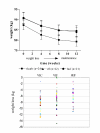Comparison of isocaloric very low carbohydrate/high saturated fat and high carbohydrate/low saturated fat diets on body composition and cardiovascular risk
- PMID: 16403234
- PMCID: PMC1368980
- DOI: 10.1186/1743-7075-3-7
Comparison of isocaloric very low carbohydrate/high saturated fat and high carbohydrate/low saturated fat diets on body composition and cardiovascular risk
Abstract
Background: It is speculated that high saturated fat very low carbohydrate diets (VLCARB) have adverse effects on cardiovascular risk but evidence for this in controlled studies is lacking. The objective of this study was to compare, under isocaloric conditions, the effects of a VLCARB to 2 low saturated fat high carbohydrate diets on body composition and cardiovascular risk.
Methods: Eighty three subjects, 48 +/- 8 y, total cholesterol 5.9 +/- 1.0 mmol/L, BMI 33 +/- 3 kg/m2 were randomly allocated to one of 3 isocaloric weight loss diets (6 MJ) for 8 weeks and on the same diets in energy balance for 4 weeks: Very Low Fat (VLF) (CHO:Fat:Protein; %SF = 70:10:20; 3%), High Unsaturated Fat (HUF) = (50:30:20; 6%), VLCARB (4:61:35; 20%)
Results: Percent fat mass loss was not different between diets VLCARB -4.5 +/- 0.5, VLF-4.0 +/- 0.5, HUF -4.4 +/- 0.6 kg). Lean mass loss was 32-31% on VLCARB and VLF compared to HUF (21%) (P < 0.05). LDL-C increased significantly only on VLCARB by 7% (p < 0.001 compared with the other diets) but apoB was unchanged on this diet and HDL-C increased relative to the other 2 diets. Triacylglycerol was lowered by 0.73 +/- 0.12 mmol/L on VLCARB compared to -0.15 +/- 0.07 mmol/L on HUF and -0.06 +/- 0.13 mmol/L on VLF (P < 0.001). Plasma homocysteine increased 6.6% only on VLCARB (P = 0.026). VLCARB lowered fasting insulin 33% compared to a 19% fall on HUF and no change on VLF (P < 0.001). The VLCARB meal also provoked significantly lower post prandial glucose and insulin responses than the VLF and HUF meals. All diets decreased fasting glucose, blood pressure and CRP (P < 0.05).
Conclusion: Isocaloric VLCARB results in similar fat loss than diets low in saturated fat, but are more effective in improving triacylglycerols, HDL-C, fasting and post prandial glucose and insulin concentrations. VLCARB may be useful in the short-term management of subjects with insulin resistance and hypertriacylglycerolemia.
Figures






References
-
- Zhu S, Wang Z, Heshka S, Heo M, Faith MS, Heymsfield SB. Waist circumference and obesity-associated risk factors among whites in the third National Health and Nutrition Examination Survey: clinical action thresholds. Am J Clin Nutr. 2002;76:743–749. - PubMed
-
- Noakes M, Clifton PM. Changes in plasma lipids and other cardiovascular risk factors during 3 energy-restricted diets differing in total fat and fatty acid composition. Am J Clin Nutr. 2000;71:706–712. - PubMed
-
- Maru S, van der Schouw YT, Gimbrere CH, Grobbee DE, Peeters PH. Body mass index and short-term weight change in relation to mortality in Dutch women after age 50 y. Am J Clin Nutr. 2004;80:231–236. - PubMed
-
- Williamson DF, Pamuk E, Thun M, Flanders D, Byers T, Heath C. Prospective study of intentional weight loss and mortality in never-smoking overweight US white women aged 40-64 years. Am J Epidemiol. 1995;141:1128–1141. - PubMed
LinkOut - more resources
Full Text Sources
Research Materials
Miscellaneous

